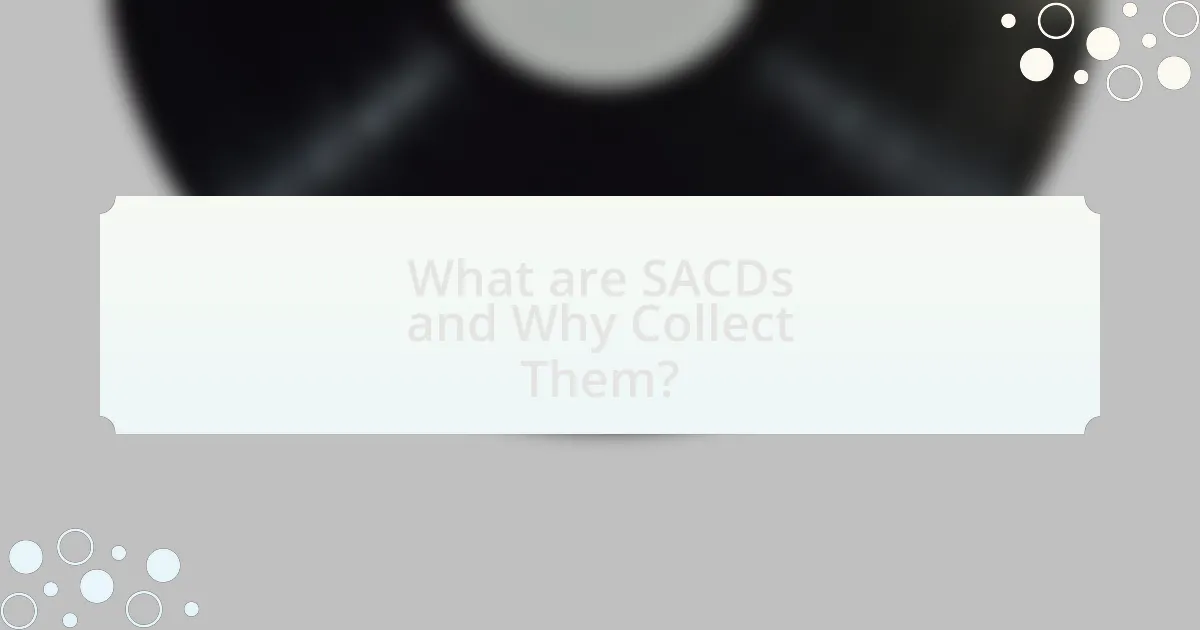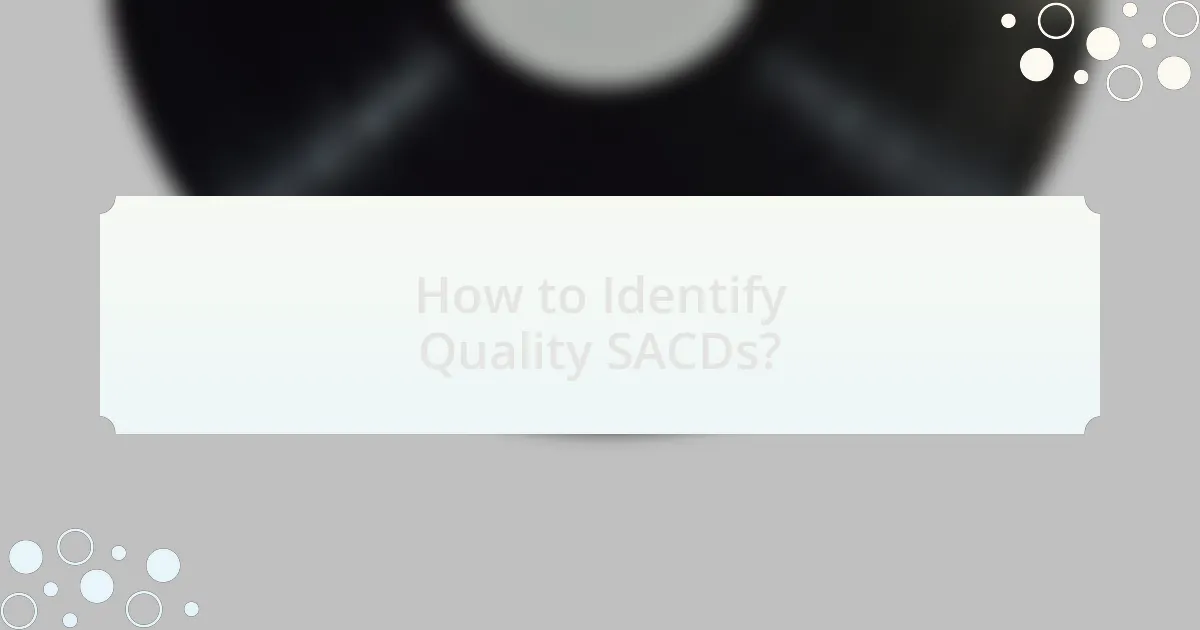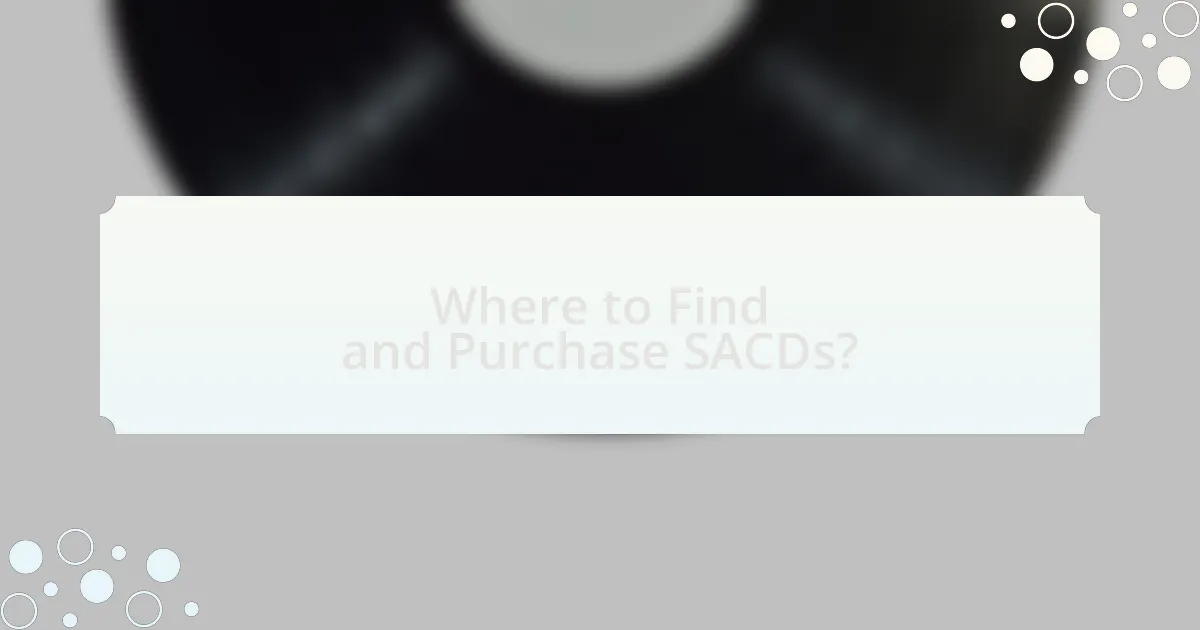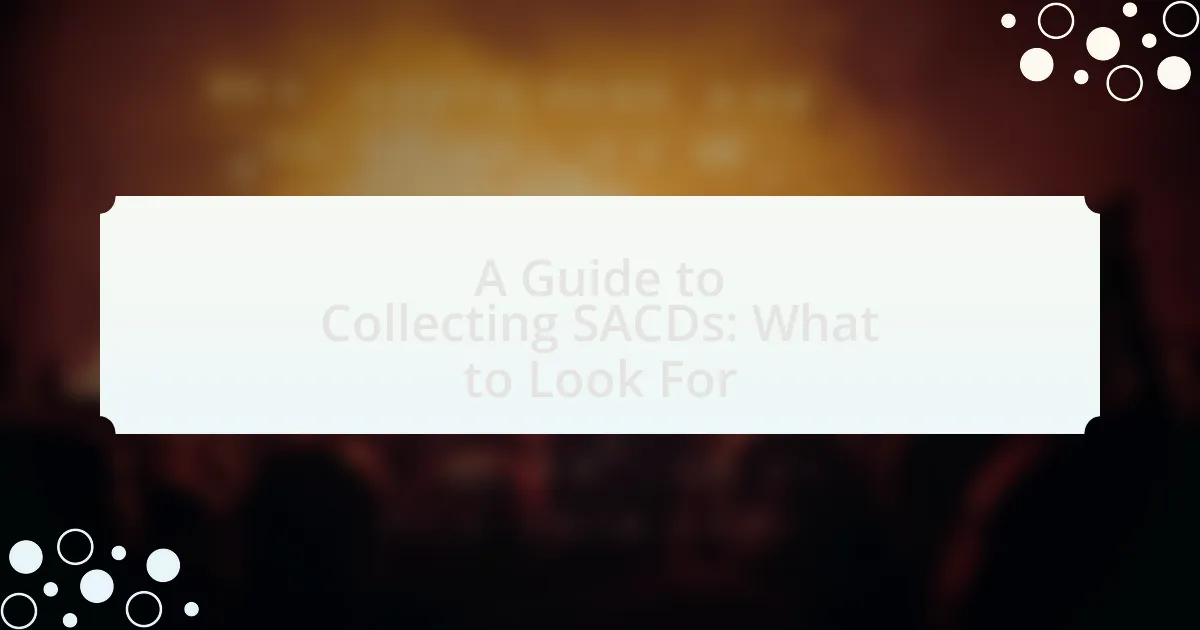SACDs, or Super Audio CDs, are high-fidelity audio discs that offer superior sound quality compared to standard CDs, making them highly sought after by audiophiles and collectors. This guide provides an overview of SACDs, including their history, technological advancements, and unique features that enhance audio quality. It also outlines the different types of SACDs available, factors to consider when starting a collection, and tips for identifying quality discs. Additionally, the article discusses common pitfalls to avoid, where to purchase SACDs, and strategies for expanding and maintaining a collection effectively.
What are SACDs and Why Collect Them?

SACDs, or Super Audio CDs, are high-fidelity audio discs designed to provide superior sound quality compared to standard CDs. Collecting SACDs is appealing due to their advanced audio technology, which includes a higher sampling rate and bit depth, allowing for a more immersive listening experience. Additionally, many SACDs feature exclusive content, such as multi-channel audio and high-resolution stereo tracks, making them desirable for audiophiles and collectors. The format was introduced by Sony and Philips in 1999, and its limited production runs for certain titles can increase their value over time, further incentivizing collectors.
What is the history of SACDs?
SACDs, or Super Audio CDs, were introduced in 1999 as a high-resolution audio format developed by Sony and Philips. The format was designed to provide superior sound quality compared to standard CDs by utilizing a different encoding method known as Direct Stream Digital (DSD), which allows for a higher sampling rate and bit depth. The first SACD players were released in 1999, and the format gained traction in the early 2000s with the release of hybrid discs that contained both SACD and standard CD layers, making them compatible with existing CD players. By 2002, major record labels began to release titles in SACD format, including classical, jazz, and popular music, contributing to its niche market. Despite its initial promise, SACD’s popularity waned in the late 2000s due to the rise of digital downloads and streaming services, leading to a decline in new releases and player availability. However, SACDs continue to be produced and collected by audiophiles who appreciate their high-fidelity sound.
How did SACDs evolve from traditional CDs?
SACDs evolved from traditional CDs by utilizing a different audio format that allows for higher fidelity sound. While CDs use a 16-bit/44.1 kHz PCM audio format, SACDs employ a 1-bit DSD (Direct Stream Digital) format, which provides a broader dynamic range and improved sound quality. This evolution was driven by the demand for superior audio experiences, leading to the introduction of SACDs in 1999 by Sony and Philips as a response to the limitations of CDs in delivering high-resolution audio.
What technological advancements do SACDs offer?
SACDs, or Super Audio CDs, offer several technological advancements, primarily in audio quality and format versatility. They utilize Direct Stream Digital (DSD) encoding, which provides a higher resolution audio experience compared to standard CDs, allowing for a more accurate representation of sound. Additionally, SACDs support multi-channel audio, enabling surround sound playback, which enhances the listening experience. The hybrid format of SACDs allows them to be played on standard CD players, making them accessible while still providing high-resolution audio on compatible devices. These advancements collectively contribute to SACDs being favored by audiophiles for their superior sound fidelity and versatility.
What makes SACDs unique compared to other formats?
SACDs are unique compared to other formats primarily due to their ability to store high-resolution audio using a technology called Direct Stream Digital (DSD). This format allows for a greater dynamic range and improved sound quality, making it superior to standard CDs, which use Pulse Code Modulation (PCM). The DSD technology captures audio at a higher sampling rate, resulting in a more accurate representation of the original sound. Additionally, SACDs can contain both a high-resolution layer and a standard CD layer, providing versatility for playback on different devices. This dual-layer capability enhances their appeal to audiophiles seeking the best listening experience.
How do SACDs enhance audio quality?
SACDs enhance audio quality by utilizing a higher resolution audio format known as DSD (Direct Stream Digital), which allows for a more accurate representation of sound. This format operates at a sampling rate of 2.8224 MHz, significantly higher than the standard CD’s 44.1 kHz, resulting in a broader frequency response and improved dynamic range. Additionally, SACDs can support multi-channel audio, providing an immersive listening experience that stereo formats cannot match. The combination of these factors leads to a richer, more detailed sound that is closer to the original recording, making SACDs a preferred choice for audiophiles seeking superior audio fidelity.
What are the different types of SACDs available?
There are three main types of SACDs available: hybrid SACDs, single-layer SACDs, and multi-channel SACDs. Hybrid SACDs contain both a standard CD layer and a high-resolution SACD layer, allowing playback on regular CD players and SACD players. Single-layer SACDs consist solely of the high-resolution SACD layer, requiring an SACD player for playback. Multi-channel SACDs offer surround sound capabilities, providing an immersive audio experience by utilizing multiple audio channels. These distinctions are essential for collectors to understand the format and playback options available.
What should collectors consider when starting their SACD collection?
Collectors should consider the sound quality, availability of titles, and the format’s compatibility with their equipment when starting their SACD collection. Sound quality is paramount, as SACDs are known for their high-resolution audio, which can significantly enhance the listening experience compared to standard CDs. Availability of titles is also crucial, as not all albums are released in SACD format, so collectors should research which artists and genres are well-represented. Lastly, compatibility with existing audio equipment is essential; collectors need to ensure they have a player that supports SACD playback, as not all standard CD players do. These considerations will help collectors build a valuable and enjoyable SACD collection.
How do you determine the value of an SACD?
To determine the value of an SACD, assess factors such as rarity, condition, demand, and market trends. Rarity significantly influences value; limited editions or out-of-print titles often command higher prices. The condition of the disc and packaging is crucial, as mint condition items are more desirable. Demand can fluctuate based on collector interest and genre popularity, impacting pricing. Additionally, researching recent sales data on platforms like eBay or specialized music forums provides insight into current market trends, helping to establish a fair value.
What factors influence the rarity of SACDs?
The rarity of SACDs is influenced by factors such as limited production runs, the popularity of the album, and the format’s declining market presence. Limited production runs often result from niche market appeal, leading to fewer copies being made. The popularity of specific albums can also dictate rarity; classic or highly sought-after titles tend to have fewer available copies, increasing their value. Additionally, as the market for SACDs has diminished since their peak in the early 2000s, fewer new releases contribute to the overall scarcity of the format.
How to Identify Quality SACDs?

To identify quality SACDs, examine the mastering process and the label’s reputation. Quality SACDs typically feature high-resolution audio mastered from original analog tapes or high-quality digital sources, ensuring superior sound fidelity. Labels known for producing quality SACDs, such as Mobile Fidelity Sound Lab and Analogue Productions, often provide detailed information about the mastering process on the packaging. Additionally, check for reviews and ratings from audiophile communities, as these can provide insights into the sound quality and overall production standards of specific titles.
What features should you look for in a high-quality SACD?
A high-quality SACD should feature a multi-channel audio format, which allows for a more immersive listening experience. This format typically includes both stereo and surround sound options, enhancing the depth and clarity of the music. Additionally, look for SACDs that utilize DSD (Direct Stream Digital) encoding, as this technology provides superior sound quality compared to traditional PCM formats. The presence of high-resolution audio tracks is also crucial, as they offer greater detail and fidelity. Furthermore, consider the quality of the mastering process; SACDs that have been mastered by reputable engineers or studios are likely to deliver a better listening experience. Lastly, check for the inclusion of bonus content, such as additional tracks or behind-the-scenes material, which can add value to the SACD.
How does the mastering process affect SACD quality?
The mastering process significantly impacts SACD quality by determining the final sound characteristics and fidelity of the recording. During mastering, audio engineers optimize the sound for the specific format, ensuring that the high-resolution capabilities of SACD are fully utilized. This includes adjustments to equalization, dynamic range, and overall loudness, which can enhance clarity and depth. For instance, a well-mastered SACD can reveal nuances in the music that are not present in lower-resolution formats, providing a richer listening experience. The precision in mastering directly correlates with the ability to capture and reproduce the full spectrum of sound, making it a critical step in the production of high-quality SACDs.
What role do labels play in SACD quality assurance?
Labels play a crucial role in SACD quality assurance by ensuring that the audio content meets specific technical and artistic standards. They are responsible for the production process, which includes mastering, encoding, and quality control, to guarantee that the final product delivers high-fidelity sound. Labels often employ experienced engineers and utilize advanced technology to maintain the integrity of the audio during the SACD creation process, which is essential for achieving the superior sound quality that SACDs are known for.
What are common pitfalls to avoid when collecting SACDs?
Common pitfalls to avoid when collecting SACDs include purchasing counterfeit discs, neglecting to verify compatibility with playback equipment, and overlooking the condition of the disc. Counterfeit SACDs can often be indistinguishable from genuine ones, leading collectors to spend money on inferior products. Additionally, not all players support SACD formats, so collectors should confirm compatibility to avoid disappointment. Lastly, the condition of the disc is crucial; scratches or damage can significantly affect sound quality, making it essential to inspect each item before purchase.
How can you spot counterfeit SACDs?
To spot counterfeit SACDs, examine the packaging and disc for inconsistencies in print quality, as authentic SACDs typically feature high-resolution artwork and clear text. Authentic SACDs often have a holographic sticker or a specific serial number on the spine, which counterfeit versions may lack or misrepresent. Additionally, check the disc’s reflective surface; genuine SACDs have a distinct layer that differentiates them from standard CDs, often appearing more polished.
What mistakes do new collectors often make?
New collectors often make the mistake of not researching the market value of SACDs before purchasing. This lack of knowledge can lead to overpaying for items that may not hold their value or are readily available at lower prices. Additionally, many new collectors fail to consider the condition of the discs and packaging, which significantly affects their resale value. According to industry experts, understanding grading standards and market trends is crucial for making informed buying decisions.
Where to Find and Purchase SACDs?

SACDs can be found and purchased at various online retailers, specialty music stores, and auction sites. Major online platforms like Amazon and eBay offer a wide selection of SACDs, while dedicated music retailers such as Acoustic Sounds and Elusive Disc specialize in high-fidelity audio formats, including SACDs. Additionally, local record stores may carry SACDs, particularly those that focus on audiophile products. Collectors often find rare titles through online marketplaces and forums dedicated to music collecting.
What are the best places to buy SACDs?
The best places to buy SACDs include specialized online retailers, local record stores, and auction sites. Online retailers such as Acoustic Sounds and Music Direct offer a wide selection of new and used SACDs, often with detailed descriptions and customer reviews. Local record stores may carry SACDs, especially those that focus on audiophile products. Auction sites like eBay provide access to rare and collectible SACDs, allowing buyers to find unique titles that may not be available elsewhere. These sources are recognized for their extensive inventories and commitment to quality, making them reliable options for SACD purchases.
How do online marketplaces compare to local record stores?
Online marketplaces generally offer a wider selection of SACDs compared to local record stores. This is due to the vast inventory available from multiple sellers on platforms like eBay, Discogs, and Amazon, which can include rare and out-of-print titles that local stores may not carry. Additionally, online marketplaces often provide competitive pricing due to the presence of numerous sellers, allowing buyers to compare prices easily. In contrast, local record stores may offer a more curated selection and the advantage of immediate purchase and physical inspection of the product, which can enhance the buying experience. However, the limited space and inventory of local stores can restrict the variety available to collectors.
What should you consider when buying SACDs from auctions?
When buying SACDs from auctions, consider the condition of the disc and packaging, as these factors significantly affect value and playback quality. Inspect the auction listing for detailed descriptions and photographs that reveal any scratches, dents, or wear on the SACD and its case. Additionally, verify the authenticity of the SACD, as counterfeit products can be prevalent in auctions. Research the seller’s reputation and feedback ratings to ensure a trustworthy transaction. Finally, be aware of the auction’s terms, including shipping costs and return policies, to avoid unexpected expenses or complications.
How can you expand your SACD collection effectively?
To expand your SACD collection effectively, focus on researching and identifying sought-after titles, exploring online marketplaces, and attending local record stores or music fairs. Researching involves checking lists of critically acclaimed SACDs, such as those recognized by audiophile communities, which often highlight releases with superior sound quality. Online marketplaces like eBay, Discogs, and specialized audiophile forums provide access to a wide range of SACDs, including rare finds. Additionally, visiting local record stores or music fairs can yield unique opportunities to discover SACDs that may not be available online, allowing collectors to engage with sellers and other enthusiasts for recommendations.
What strategies can help you find rare SACDs?
To find rare SACDs, utilize online marketplaces, specialized music forums, and local record stores. Online platforms like eBay and Discogs often have listings for rare SACDs, allowing collectors to search by specific titles or labels. Engaging in music forums and communities can provide leads on where to find rare items, as members frequently share tips and sales. Additionally, local record stores may have hidden gems, so visiting them regularly can yield unexpected finds. Collectors often report success in these areas, confirming that a combination of online and offline strategies enhances the chances of discovering rare SACDs.
How can joining collector communities enhance your collection?
Joining collector communities can significantly enhance your collection by providing access to valuable knowledge, resources, and networking opportunities. These communities often share insights on rare finds, market trends, and preservation techniques, which can help collectors make informed decisions. For instance, members frequently exchange information about upcoming releases or limited editions, allowing collectors to acquire items that may not be widely available. Additionally, participating in these groups fosters connections with other enthusiasts, enabling collaboration on trades or sales, which can lead to acquiring sought-after pieces. Research indicates that community engagement can increase the overall satisfaction and success of collectors, as they benefit from shared experiences and collective expertise.
What are some tips for maintaining your SACD collection?
To maintain your SACD collection, store the discs vertically in a cool, dry environment to prevent warping and scratching. Proper storage minimizes exposure to heat and humidity, which can damage the discs over time. Additionally, handle SACDs by the edges to avoid fingerprints and smudges on the surface, as these can affect playback quality. Regularly clean the discs with a soft, lint-free cloth, wiping from the center outward to avoid scratches. Using protective cases can further safeguard the discs from dust and physical damage, ensuring their longevity.
How should you store SACDs to prevent damage?
To prevent damage to SACDs, store them vertically in a cool, dry environment away from direct sunlight. This method minimizes the risk of warping and scratches, which can occur if discs are stacked horizontally or exposed to heat. Additionally, using protective cases specifically designed for SACDs can further safeguard against physical damage and dust accumulation. Proper storage conditions, such as maintaining a stable temperature and humidity level, are essential for preserving the integrity of the discs over time.
What cleaning methods are safe for SACDs?
Safe cleaning methods for SACDs include using a microfiber cloth and distilled water. Microfiber cloths are non-abrasive and effectively remove dust and fingerprints without scratching the disc surface. Distilled water is recommended because it does not contain minerals that could leave deposits on the disc. Additionally, cleaning should be done in a straight line from the center to the edge of the disc to avoid circular scratches. These methods are supported by industry practices for maintaining optical media, ensuring the longevity and performance of SACDs.

Leave a Reply